Bioactive β-Carbolines Harman and Norharman in Sesame Seed Oils in China
Abstract
:1. Introduction
2. Results and Discussion
2.1. Analysis of β-Carbolines in Fragrant Sesame Seed Oils
2.2. Analysis of β-Carbolines in Cold-Pressed Sesame Seed Oils
2.3. Comparison of Fragrant and Cold-Pressed Sesame Seed Oils
2.4. Effect of Sesame Seed Roasting Process on the Level of β-Carbolines
3. Materials and Methods
3.1. Materials
3.2. Methods
3.2.1. Model Roasting Process for Sesame Seeds and Oil Extraction
3.2.2. Analysis of Fatty Acid Composition of Sesame Seed Oil
3.2.3. Determination of Free Amino Acids in Defatted Sesame Cake
3.2.4. Extraction, Purification and Analysis of Heterocyclic Aromatic Amines
3.2.5. Statistical Analysis
4. Conclusions
Supplementary Materials
Author Contributions
Funding
Institutional Review Board Statement
Informed Consent Statement
Data Availability Statement
Conflicts of Interest
Sample Availability
References
- Piechowska, P.; Zawirska-Wojtasiak, R.; Mildner-Szkudlarz, S. Bioactive β-Carbolines in Food: A Review. Nutrients 2019, 11, 814. [Google Scholar] [CrossRef] [PubMed] [Green Version]
- Wojtowicz, E.; Zawirska-Wojtasiak, R.; Przygoński, K.; Mildner-Szkudlarz, S. Bioactive β-carbolines norharman and harman in traditional and novel raw materials for chicory coffee. Food Chem. 2015, 175, 280–283. [Google Scholar] [CrossRef] [PubMed]
- Xie, Z.; Cao, N.; Wang, C. A review on β-carboline alkaloids and their distribution in foodstuffs: A class of potential functional components or not? Food Chem. 2021, 348, 129067. [Google Scholar] [CrossRef] [PubMed]
- Gibis, M. Heterocyclic aromatic amines in cooked meat products: Causes, formation, occurrence, and risk assessment. Compr. Rev. Food Sci. Food Saf. 2016, 15, 269–302. [Google Scholar] [CrossRef]
- Sun, J.H.; Yohan, Y.; Cheorun, J.; Jong, Y.J.; Keun, T.L. Effect of Dietary Red Meat on Colorectal Cancer Risk—A Review. Compr. Rev. Food Sci. Food Saf. 2019, 18, 1812–1824. [Google Scholar]
- Sun, J.H.; Cheorun, J.; Yohan, Y.; Jong, Y.J.; Keun, T.L. Controversy on the correlation of red and processed meat consumption with colorectal cancer risk: An Asian perspective. Crit. Rev. Food Sci. Nutr. 2019, 59, 3526–3537. [Google Scholar]
- Herraiz, T. Identification and occurrence of the bioactive β-carbolinesnorharman and harman in coffee brews. Food Addit. Contam. 2002, 19, 748–754. [Google Scholar] [CrossRef]
- Herraiz, T. Relative exposure to β-carbolinesnorharman and harman from foods and tobacco smoke. Food Addit. Contam. 2004, 21, 1041–1050. [Google Scholar] [CrossRef]
- Nadeem, H.R.; Akhtar, S.; Ismail, T.; Sestili, P.; Lorenzo, J.M.; Ranjha, M.M.A.N.; Jooste, L.; Hano, C.; Aadil, R.M. Heterocyclic Aromatic Amines in Meat: Formation, Isolation, Risk Assessment, and Inhibitory Effect of Plant Extracts. Foods 2021, 10, 1466. [Google Scholar] [CrossRef]
- Gao, P.; Cao, Y.; Liu, R.; Jin, Q.; Wang, X. Phytochemical content, minor-constituent compositions, and antioxidant capacity of screw-pressed walnut oil obtained from roasted kernels. Eur. J. Lipid Sci. Technol. 2019, 121, 1800292. [Google Scholar] [CrossRef] [Green Version]
- Chang, C.C.; Zhang, D.; Wang, Z.; Chen, B.H. Simultaneous determination of twenty heterocyclic amines in cooking oil using dispersive solid phase extraction (QuEChERS) and high performance liquid chromatography-electrospray-tandem mass spectrometry. J. Chromatogr. A 2019, 1585, 82–91. [Google Scholar] [CrossRef]
- Ahmed, I.A.M.; Uslu, N.; Ozcan, M.M.; Juhaimi, F.A.L.; Ghafoor, K.; Babiker, E.E.; Osman, M.A.; Alqah, H.A.S. Effect of conventional oven roasting treatment on the physicochemical quality attributes of sesame seeds obtained from different locations. Food Chem. 2021, 338, 128109. [Google Scholar] [CrossRef]
- Zhang, D.; Li, X.; Cao, Y.; Wang, C.; Xue, Y. Effect of roasting on the chemical components of peanut oil. LWT Food Sci. Technol. 2020, 125, 109249. [Google Scholar] [CrossRef]
- Zhang, C.X.; Xi, J.; Zhao, T.P.; Ma, Y.X.; Wang, X.D. β-carbolinesnorharman and harman in vegetable oils in China. Food Addit. Contam. Part B Surveill. 2020, 13, 193–199. [Google Scholar] [CrossRef]
- Wu, W.; Lv, M. Optimization of an improved aqueous method for production of high quality white sesame oil and de-oiled meal. Grasasy Aceites 2020, 71, e349. [Google Scholar]
- Shi, L.K.; Zheng, L.; Zhang, Y.R.; Liu, R.J.; Chang, M.; Huang, J.; Jin, Q.; Zhang, H.; Wang, X. Evaluation and Comparison of Lipid Composition, Oxidation Stability, and Antioxidant Capacity of Sesame Oil: An Industrial-Scale Study Based on Oil Extraction Method. Eur. J. Lipid Sci. Technol. 2018, 120, 1800158. [Google Scholar] [CrossRef]
- Gomez-Coca, R.B.; Alassi, M.; Moreda, W.; Perez-Camino, M.D. Pyropheophytina in Soft Deodorized Olive Oils. Foods 2020, 9, 978. [Google Scholar] [CrossRef]
- Lee, J.G.; Suh, J.H.; Yoon, H.J. The effects of extracting procedures on occurrence of polycyclic aromatic hydrocarbons in edible oils. Food Sci. Biotechnol. 2020, 29, 1181–1186. [Google Scholar] [CrossRef] [PubMed]
- Liu, R.J.; Liu, R.R.; Shi, L.K.; Zhang, Z.Y.; Zhang, T.; Lu, M.; Chang, M.; Jin, Q.; Wang, X. Effect of refining process on physicochemical parameters, chemical compositions and in vitro antioxidant activities of rice bran oil. LWT Food Sci. Technol. 2019, 109, 26–32. [Google Scholar] [CrossRef]
- Salamatullah, A.M.; Alkaltham, M.S.; Uslu, N.; Ozcan, M.M.; Hayat, K. The effects of different roasting temperatures and times on some physicochemical properties and phenolic compounds in sesame seeds. J. Food Process. Preserv. 2021, 45, e15222. [Google Scholar] [CrossRef]
- Zhou, Q.; Geng, F.; Deng, Q.C.; Huang, F.H.; Wang, J.Q. Dynamic analysis of polar metabolites and volatile compounds in sesame seeds during roasting. Cereal Chem. 2019, 96, 358–369. [Google Scholar] [CrossRef]
- Randel, G.; Balzer, M.; Grupe, S.; Drusch, S.; Kaina, B.; Platt, K.L.; Schwarz, K. Degradation of heterocyclic aromatic amines in oil under storage and frying conditions and reduction of their mutagenic potential. Food Chem. Toxicol. 2007, 45, 2245–2253. [Google Scholar] [CrossRef] [PubMed]
- Geng, Q.; Chen, J.; Guo, R.; Zhang, L.; Li, Q.; Yu, X. Salt-assisted aqueous extraction combined with Span 20 allow the obtaining of a high-quality and yield walnut oil. LWT Food Sci. Technol. 2020, 121, 108956. [Google Scholar] [CrossRef]
- Behraad, T.; Jamshid, F.; Jafar, M.M. Enzyme-assisted aqueous extraction of oil and protein hydrolysate from sesame seed. J. Food Meas. Charact. 2019, 13, 2118–2129. [Google Scholar]
- Pan, T.; Wang, Z.Y.; Chen, B.H.; Hui, T.; Zhang, D.Q. Frying oils with lower levels of saturated fatty acids induce less heterocyclic amine formation in meat floss (boiled, shredded and fried pork). Int. J. Food Sci. Technol. 2020, 55, 823–832. [Google Scholar] [CrossRef]
- Alaejos, M.S.; Afonso, A.M. Factors That affect the content of heterocyclic aromatic amines in foods. Compr. Rev. Food Sci. Food Saf. 2011, 10, 52–108. [Google Scholar] [CrossRef]
- Herraiz, T. Identification and occurrence of beta-carboline alkaloids in raisins and inhibition of monoamine oxidase (MAO). J. Agric. Food Chem. 2007, 55, 8534–8540. [Google Scholar] [CrossRef]
- Herraiz, T. Tetrahydro-beta-carboline-3-carboxylic acid compounds in fish and meat: Possible precursors of co-mutagenic beta-carbolines norharman and harman in cooked foods. Food Addit. Contam. 2000, 17, 859–866. [Google Scholar] [CrossRef]
- Ji, J.; Liu, Y.; Shi, L.; Wang, N.; Wang, X. Effect of roasting treatment on the chemical composition of sesame oil. LWT Food Sci. Technol. 2019, 101, 191–200. [Google Scholar] [CrossRef]
- Song, J.; Bi, J.; Chen, Q.; Wu, X.; Lyu, Y.; Meng, X. Assessment of sugar content, fatty acids, free amino acids, and volatile profiles in jujube fruits at different ripening stages. Food Chem. 2018, 270, 344–352. [Google Scholar] [CrossRef] [PubMed]
- Liu, W.; Yang, Z.; Shi, L.; Cui, Z.; Li, Y. Degradation of β-carbolines harman and norharman in edible oils during heating. Molecules 2021, 26, 7018. [Google Scholar] [CrossRef]
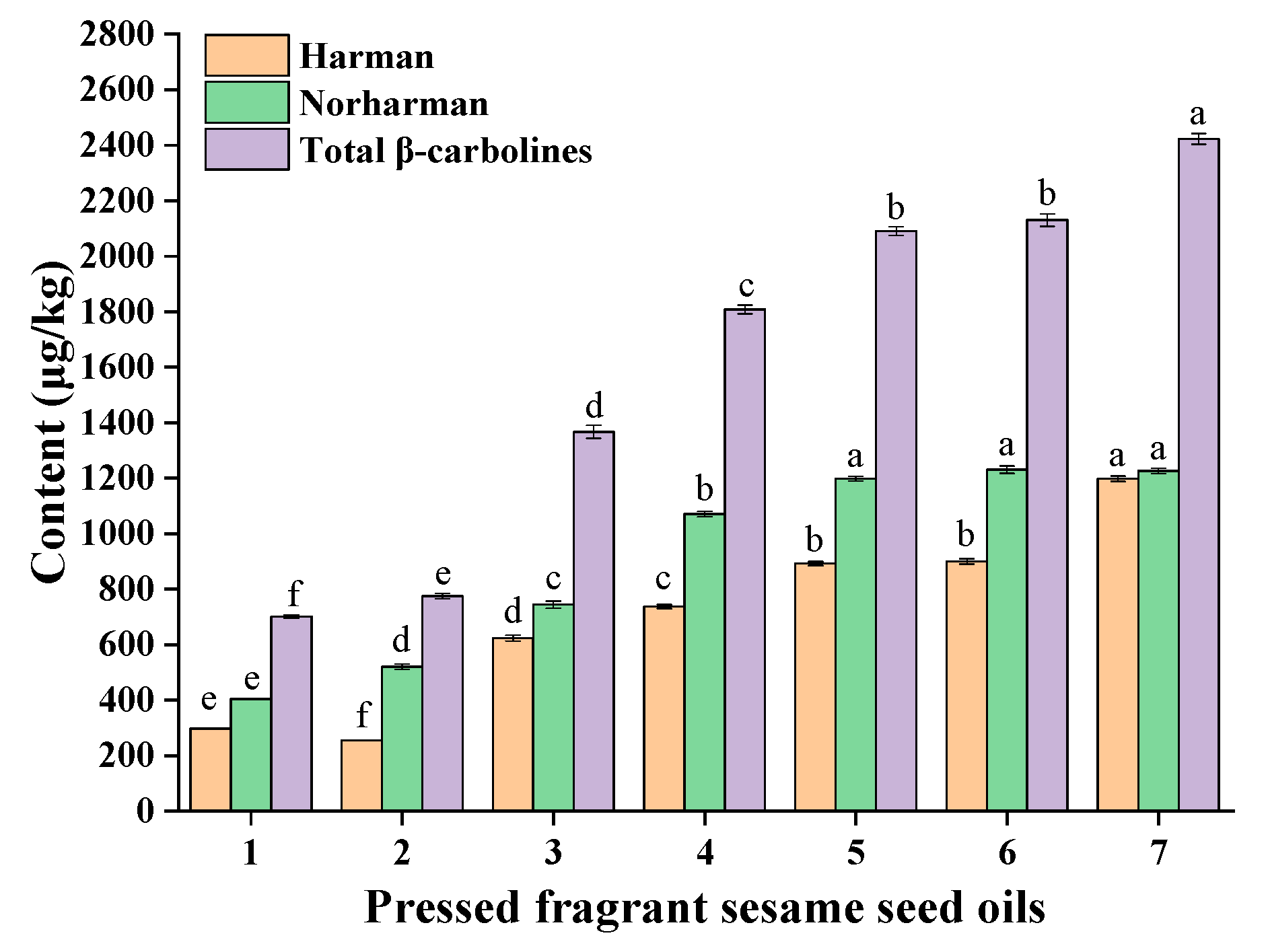
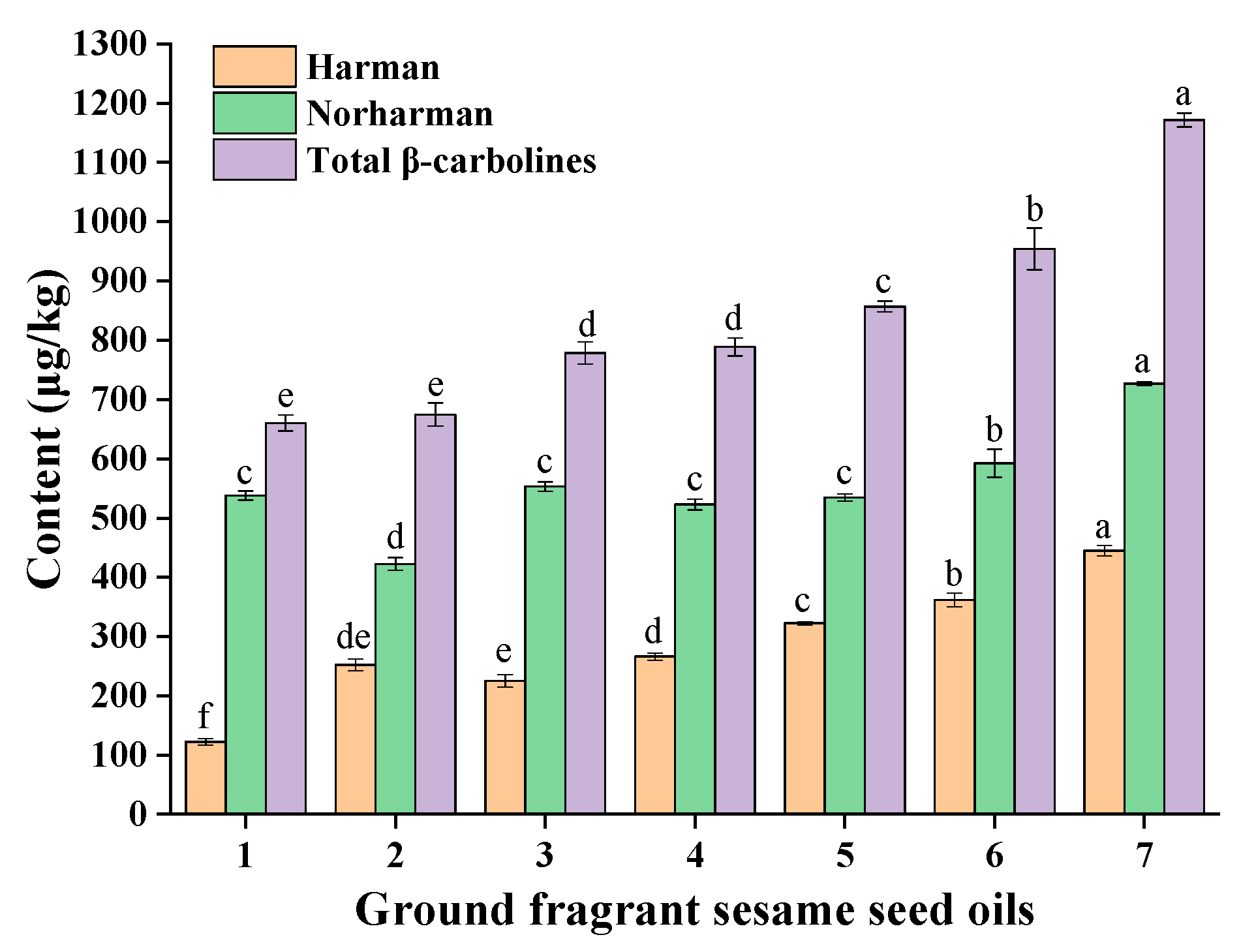
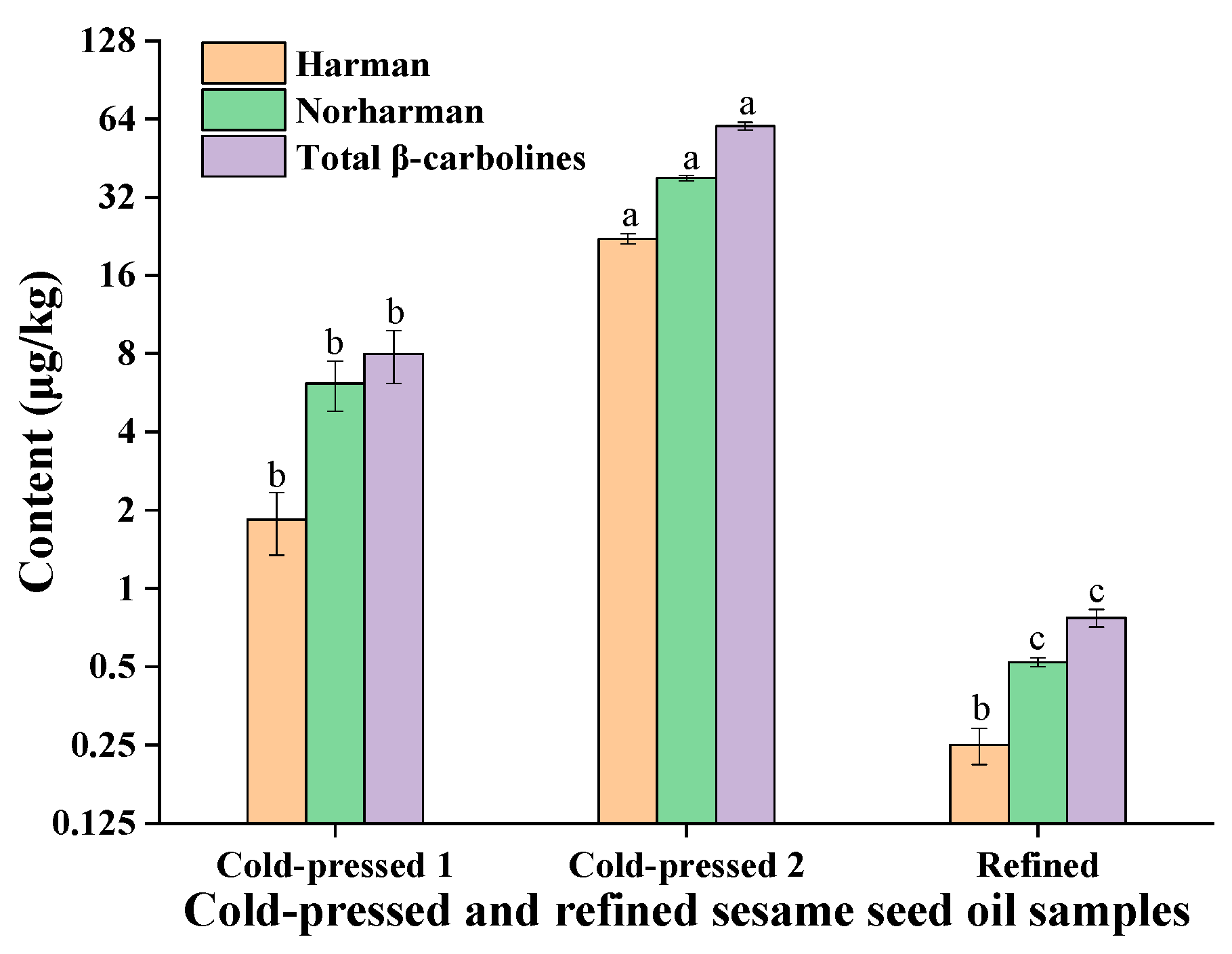

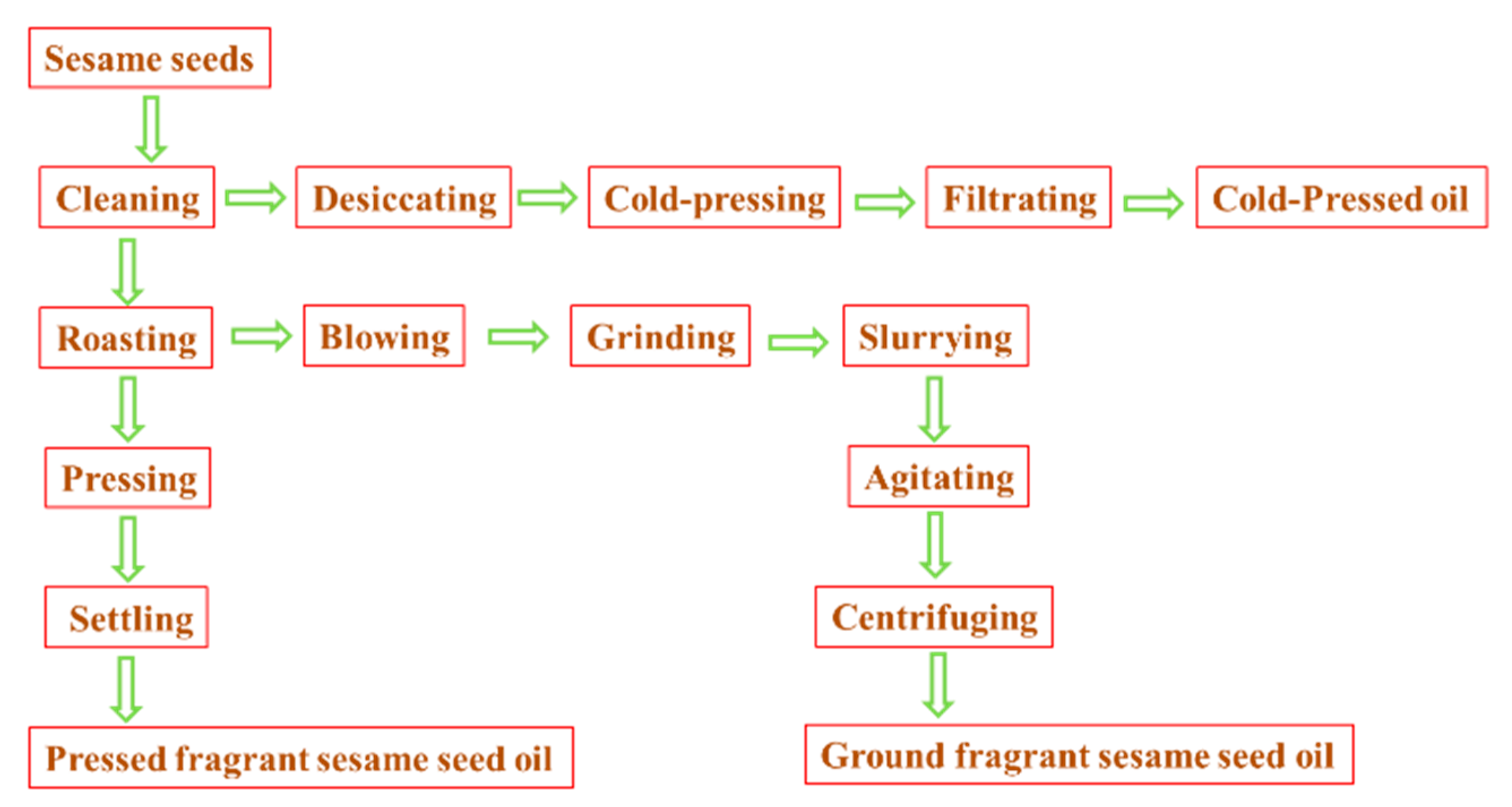
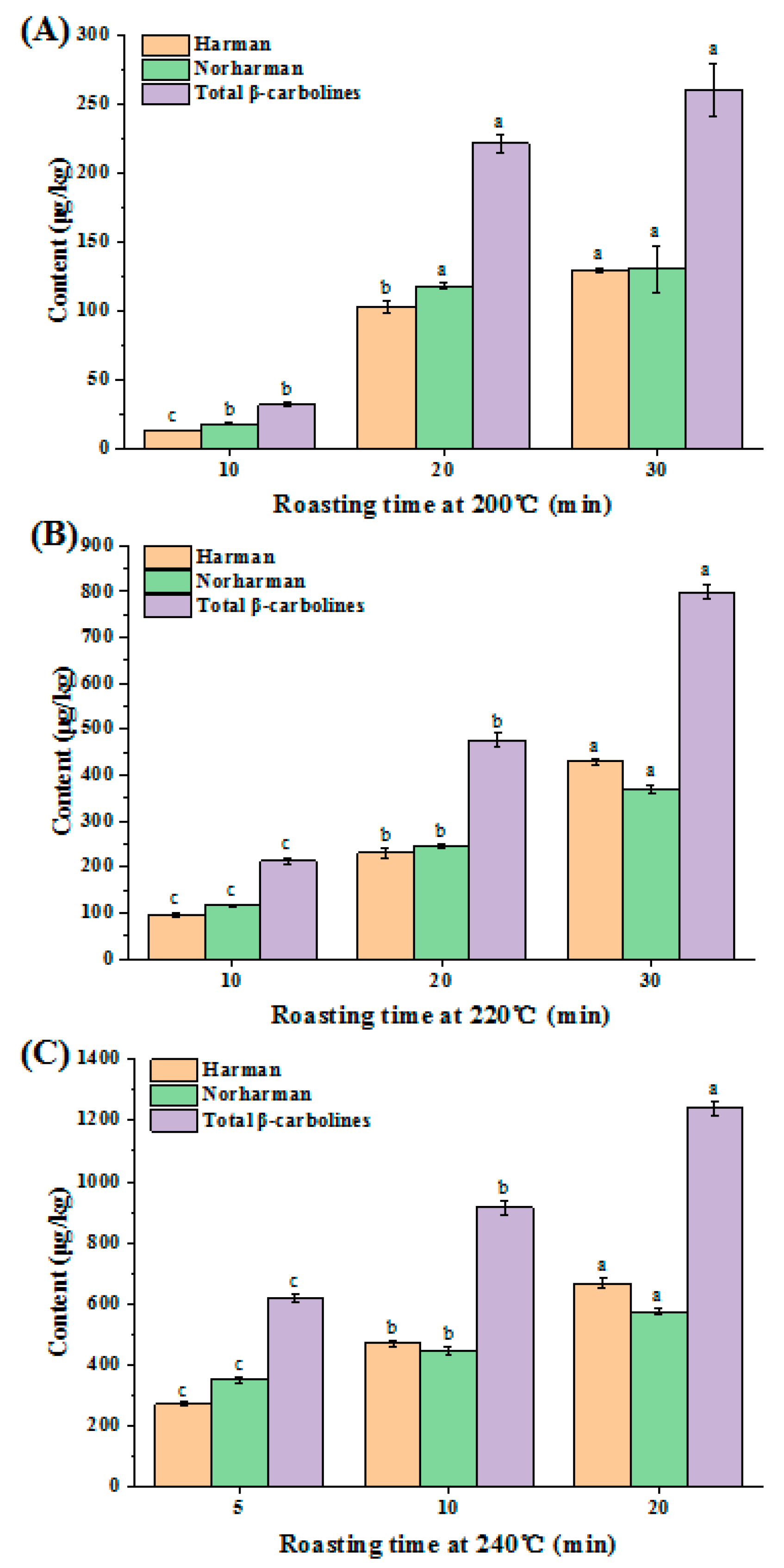


| HAA (μg/kg) | Pressed Fragrant Sesame Seed Oils (7 Samples) | Ground Fragrant Sesame Seed Oils (7 Samples) | Cold-Pressed Sesame Seed Oils (2 Samples) |
|---|---|---|---|
| AαC | ND b | ND | ND |
| MeAαC | ND | ND | ND |
| Trp-P-1 | ND | ND | ND |
| DMIP | ND | ND | ND |
| Glu-P-2 | ND | ND | ND |
| MeIQ | ND | ND | ND |
| MeIQx | ND | ND | ND |
| IQ | ND | ND | ND |
| PhIP | ND | ND | ND |
| 4,8-DiMeIQx | ND | ND | ND |
| 7,8-DiMeIQx | ND | ND | ND |
| Harman | 254.0–1197.7 | 122.5–444.9 | 1.8–22.1 |
| Norharman | 403.6–1230.7 | 422.3–726.8 | 6.2–37.9 |
| Trp-P-2 | ND | ND | ND |
| Fatty Acid | Control | 200 °C | 220 °C | 240 °C | ||||||
|---|---|---|---|---|---|---|---|---|---|---|
| 10 min | 20 min | 30 min | 10 min | 20 min | 30 min | 5 min | 10 min | 20 min | ||
| C16:0 | 9.68 ± 0.03 d,e | 9.66 ± 0.02 e | 9.73 ± 0.09 c,d,e | 9.74 ± 0.03 c,d | 9.74 ± 0.02 c,d | 9.79 ± 0.02 b,c | 9.91 ± 0.02 a | 9.85 ± 0.00 a,b | 9.88 ± 0.01 a | 9.92 ± 0.03 a |
| C18:0 | 6.09 ± 0.01 b | 6.23 ± 0.03 a | 6.22 ± 0.10 a | 6.26 ± 0.05 a | 6.18 ± 0.03 a,b | 6.21 ± 0.04 a | 6.23 ± 0.01 a | 6.19 ± 0.03 a,b | 6.20 ± 0.02 a | 6.24 ± 0.01 a |
| ΣSFA | 15.77 ± 0.04 d | 15.89 ± 0.05 c,d | 15.95 ± 0.19 b,c | 16.00 ± 0.08 a,b,c | 15.93 ± 0.05 b,c,d | 15.99 ± 0.06 a,b,c | 16.14 ± 0.03 a | 16.03 ± 0.03 a,b,c | 16.08 ± 0.03 ab | 16.16 ± 0.04 a |
| C18:1 | 42.42 ± 0.06 b | 42.60 ± 0.01 b | 42.50 ± 0.13 b | 42.58 ± 0.02 b | 42.79 ± 0.17 a | 42.84 ± 0.09 a | 42.88 ± 0.10 a | 42.84 ± 0.02 a | 42.90 ± 0.07 a | 42.88 ± 0.04 a |
| C18:2 | 41.81 ± 0.02 a | 41.52 ± 0.02 b | 41.55 ± 0.06 b | 41.42 ± 0.02 b,c | 41.28 ± 0.16 c,d | 41.17 ± 0.03 d,e | 40.99 ± 0.14 f | 41.13 ± 0.02 d,e,f | 41.02 ± 0.04 e,f | 40.96 ± 0.02 f |
| ΣUFA | 84.23 ± 0.08 a | 84.11 ± 0.03 a,b | 84.05 ± 0.19 b,c | 84.00 ± 0.04 b,c,d,e | 84.07 ± 0.34 b,c | 84.01 ± 0.12 b,c,d | 83.87 ± 0.24 d,e | 83.97 ± 0.03 b,c,d,e | 83.92 ± 0.10 c,d,e | 83.84 ± 0.05 e |
Publisher’s Note: MDPI stays neutral with regard to jurisdictional claims in published maps and institutional affiliations. |
© 2022 by the authors. Licensee MDPI, Basel, Switzerland. This article is an open access article distributed under the terms and conditions of the Creative Commons Attribution (CC BY) license (https://creativecommons.org/licenses/by/4.0/).
Share and Cite
Liu, W.; Yang, Z.; Shi, L.; Li, Y. Bioactive β-Carbolines Harman and Norharman in Sesame Seed Oils in China. Molecules 2022, 27, 402. https://doi.org/10.3390/molecules27020402
Liu W, Yang Z, Shi L, Li Y. Bioactive β-Carbolines Harman and Norharman in Sesame Seed Oils in China. Molecules. 2022; 27(2):402. https://doi.org/10.3390/molecules27020402
Chicago/Turabian StyleLiu, Wei, Zhaoyu Yang, Lili Shi, and Yun Li. 2022. "Bioactive β-Carbolines Harman and Norharman in Sesame Seed Oils in China" Molecules 27, no. 2: 402. https://doi.org/10.3390/molecules27020402
APA StyleLiu, W., Yang, Z., Shi, L., & Li, Y. (2022). Bioactive β-Carbolines Harman and Norharman in Sesame Seed Oils in China. Molecules, 27(2), 402. https://doi.org/10.3390/molecules27020402






